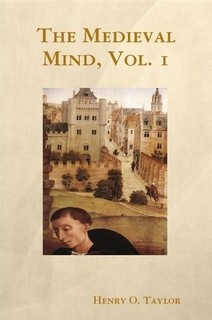paperback and e-book formats
English language
Published 1951 by Public Domain.
A History of the Development of Thought and Emotion in the Middle Ages

paperback and e-book formats
English language
Published 1951 by Public Domain.
The Middle Ages! They seem so far away; intellectually so preposterous, spiritually so strange. Bits of them may touch our sympathy, please our taste; their window-glass, their sculpture, certain of their stories, their romances,—as if those straitened ages really were the time of romance, which they were not, God knows, in the sense commonly taken. Yet perhaps they were such intellectually, or at least spiritually. Their terra—not for them incognita, though full of mystery and pall and vaguer glory—was not the earth. It was the land of metaphysical construction and the land of spiritual passion. There lay their romance, thither pointed their veriest thinking, thither drew their utter yearning. Is it possible that the Middle Ages should speak to us, as through a common humanity? Their mask is by no means dumb: in full voice speaks the noble beauty of Chartres Cathedral. Such mediaeval product, we hope, is of the …
The Middle Ages! They seem so far away; intellectually so preposterous, spiritually so strange. Bits of them may touch our sympathy, please our taste; their window-glass, their sculpture, certain of their stories, their romances,—as if those straitened ages really were the time of romance, which they were not, God knows, in the sense commonly taken. Yet perhaps they were such intellectually, or at least spiritually. Their terra—not for them incognita, though full of mystery and pall and vaguer glory—was not the earth. It was the land of metaphysical construction and the land of spiritual passion. There lay their romance, thither pointed their veriest thinking, thither drew their utter yearning. Is it possible that the Middle Ages should speak to us, as through a common humanity? Their mask is by no means dumb: in full voice speaks the noble beauty of Chartres Cathedral. Such mediaeval product, we hope, is of the universal human, and therefore of us as well as of the bygone craftsmen. Why it moves us, we are not certain, being ignorant, perhaps, of the building’s formative and earnestly intended meaning. Do we care to get at that? There is no way save by entering the mediaeval depths, penetrating to the rationale of the Middle Ages, learning the doctrinale, or emotionale, of the modes in which they still present themselves so persuasively. But if the pageant of those centuries charm our eyes with forms that seem so full of meaning, why should we stand indifferent to the harnessed processes of mediaeval thinking and the passion surging through the thought? Thought marshalled the great mediaeval procession, which moved to measures of pulsating and glorifying emotion. Shall we not press on, through knowledge, and search out its efficient causes, so that we too may feel the reality of the mediaeval argumentation, with the possible validity of mediaeval conclusions, and tread those channels of mediaeval passion which were cleared and deepened by the thought? This would be to reach human comradeship with mediaeval motives, no longer found too remote for our sympathy, or too fantastic or shallow for our understanding. But where is the path through these footless mazes? Obviously, if we would attain, perhaps, no unified, but at least an orderly presentation of mediaeval intellectual and emotional development, we must avoid entanglements with manifold and not always relevant detail. We must not drift too far with studies of daily life, habits and dress, wars and raiding, crimes and brutalities, or trade and craft and agriculture. Nor will it be wise to keep too close to theology or within the lines of growth of secular and ecclesiastical institutions. Let the student be mindful of his purpose (which is my purpose in this book) to follow through the Middle Ages the development of intellectual energy and the growth of emotion. Holding this end in view, we, students all, shall not stray from our quest after those human qualities which impelled the strivings of mediaeval men and women, informed their imaginations, and moved them to love and tears and pity. The plan and method by which I have endeavoured to realize this purpose in my book may be gathered from the Table of Contents and the First Chapter, which is introductory. These will obviate the need of sketching here the order of presentation of the successive or co-ordinated topics forming the subject-matter. Yet one word as to the standpoint from which the book is written. An historian explains by the standards and limitations of the times to which his people belong. He judges—for he must also judge—by his own best wisdom. His sympathy cannot but reach out to those who lived up to their best understanding of life; for who can do more? Yet woe unto that man whose mind is closed, whose standards are material and base.
https://www.gutenberg.org/ebooks/author/42453.https://dufs.itinerariummentis.org/book/Henry%20Osborn%20Taylor/The%20Medieval%20Mind%20-%20Henry%20Osborn%20Taylor.epub.